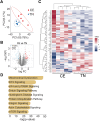Impact of short-term housing temperature alteration on metabolic parameters and adipose tissue in female mice
- PMID: 40630103
- PMCID: PMC12234322
- DOI: 10.3389/fendo.2025.1617262
Impact of short-term housing temperature alteration on metabolic parameters and adipose tissue in female mice
Abstract
Introduction: Ambient temperature significantly influences physiological and metabolic processes in rodents, affecting obesity and related disorders. Mice housed below thermoneutral temperatures exhibit increased energy expenditure and sympathetic-driven brown fat activation, whereas thermoneutral housing (~30°C) reduces these responses. This study aimed to determine whether short-term exposure to altered housing temperatures before and during pregnancy induces lasting changes in maternal adipose tissue. We hypothesized that even brief exposure during this critical window could cause persistent structural and molecular alterations in adipose tissue.
Methods: Female C57BL/6J mice were housed at cold (CE, 8°C), thermoneutral (TN, 30°C), or standard room temperature (RT, 22°C) conditions for one week before and throughout pregnancy. All mice were returned to RT post-delivery. Phenotypic assessments-including glucose tolerance, energy expenditure, histology, and proteomics-were performed after lactation.
Results: Temperature exposure did not significantly affect litter size or pup survival. CE-exposed mice showed increased total body weight driven by lean mass gains and reduced fat mass. Adipose tissue showed smaller adipocytes in iWAT and increased vascularity in BAT, though no persistent changes in thermogenic gene expression or glucose homeostasis were observed. Proteomic analysis of iWAT identified 38 differentially expressed proteins, with enrichment of pathways related to mitochondrial function and mTOR signaling.
Discussion: Short-term cold exposure induced lasting histological and proteomic changes in iWAT and BAT without sustained effects on energy metabolism, likely due to reversion to RT and limited sample size.
Conclusion: Brief temperature manipulation around pregnancy can durably alter maternal adipose tissue architecture and molecular signatures, underscoring ambient temperature as an important modulator of maternal metabolic adaptation.
Keywords: adipose tissue remodeling; ambient temperature; brown fat; maternal metabolism; thermal neutral zone.
Copyright © 2025 Paz, Shashank, Buddha, Lam, Zhang, Zhong, Sikes, Porter, Landes, Morello and Wankhade.
Conflict of interest statement
The authors declare that the research was conducted in the absence of any commercial or financial relationships that could be construed as a potential conflict of interest.
Figures







Similar articles
-
Housing temperature affects the acute and chronic metabolic adaptations to exercise in mice.J Physiol. 2019 Sep;597(17):4581-4600. doi: 10.1113/JP278221. Epub 2019 Jul 11. J Physiol. 2019. PMID: 31297830
-
Histone proteoform analysis reveals epigenetic changes in adult mouse brown adipose tissue in response to cold stress.Epigenetics Chromatin. 2024 Apr 27;17(1):12. doi: 10.1186/s13072-024-00536-8. Epigenetics Chromatin. 2024. PMID: 38678237 Free PMC article.
-
The metabolically protective energy expenditure increase of Pik3r1-related insulin resistance is not explained by Ucp1-mediated thermogenesis.Am J Physiol Endocrinol Metab. 2025 Jun 1;328(6):E743-E755. doi: 10.1152/ajpendo.00449.2024. Epub 2025 Mar 28. Am J Physiol Endocrinol Metab. 2025. PMID: 40152560 Free PMC article.
-
Antiretrovirals for reducing the risk of mother-to-child transmission of HIV infection.Cochrane Database Syst Rev. 2011 Jul 6;(7):CD003510. doi: 10.1002/14651858.CD003510.pub3. Cochrane Database Syst Rev. 2011. PMID: 21735394
-
Antiretrovirals for reducing the risk of mother-to-child transmission of HIV infection.Cochrane Database Syst Rev. 2007 Jan 24;(1):CD003510. doi: 10.1002/14651858.CD003510.pub2. Cochrane Database Syst Rev. 2007. Update in: Cochrane Database Syst Rev. 2011 Jul 06;(7):CD003510. doi: 10.1002/14651858.CD003510.pub3. PMID: 17253490 Updated.
References
-
- Osilla EV, Marsidi JL, Shumway KR, Sharma S. Physiology, temperature regulation. In: StatPearls. StatPearls Publishing, Treasure Island (FL: (2025). Available at: http://www.ncbi.nlm.nih.gov/books/NBK507838/. - PubMed
MeSH terms
Grants and funding
LinkOut - more resources
Full Text Sources
Miscellaneous

